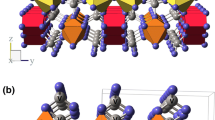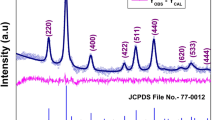Abstract
After being boiled in water, the originally amorphous mixture of coprecipitated Cu(II), Mn(II) and Fe(III) hydroxides is transformed into crystalline phases, at least one of them being ferromagnetic. Since it can not be ascertained directly whether this property is due to the presence ofγ-Fe2O3 or/and a corresponding ferrite, the identification must be based on the thermally metastable nature ofγ-Fe2O3.
The species with high Mn(II) contents exhibit temperature ranges in which the ferromagnetic properties disappear completely. This is the proof that the primarily acquired ferromagnetism stems exclusively from a ferromagnetic modification of iron oxide, namelyγ-Fe2O3.
As a result of thermal treatment at higher temperatures, the ferromagnetism reappears, this time due to the formation of ferrites.
Résumé
Les mélanges initialement amorphes des hydroxydes coprécipités de Cu(II), Mn(II) et Fe(III), se transforment, après chauffage dans de l'eau bouillante, en phase cristallines, dont l'une au moins est ferromagnétique. Comme il n'est pas possible de s'assurer directement que cette propriété est conditionnée par la présence deγ-Fe2O3 et/ou du ferrite respectif, l'identification doit reposer sur la nature thermiquement métastable deγ-Fe2O3.
Dans le cas des préparations à teneur élevée en manganèse il existe un intervalle de températures où les propriétés ferromagnétiques disparaissent complêtement. C'est la preuve de ce que le ferromagnétisme acquis primitivement provient exclusivement d'une modification ferromagnétique ou d'un oxyde, notammentγ-Fe2O3.
Le traitement thermique à des températures plus élevées a pour résultat la réapparition du ferromagnétisme, cette fois dû à la formation de ferrites.
Zusammenfassung
Die gemeinsam gefällten, ursprünglich amorphen Cu(II)Mn(II)Fe(III) Hydroxide gehen im Verlauf der Alterung durch Kochen in kristalline Phasen über, von denen wenigstens eine den Alterungsprodukten ferromagnetische Eigenschaften verleiht. Da es nicht möglich ist direkt zu entscheiden obγ-Fe2O3 oder entsprechende Ferrite diese Eigenschaft hervorrufen, ist es notwendig, sich für die Identifizierung der Alterungsprodukte die thermische Instabilität vonγ-Fe2O3 nutzbar zu machen. Die an Mn(II) sehr reichen Präparate zeigen einen Temperaturinvervall, in welchem sie überhaupt keine ferromagnetischen Eigenschaften aufweisen. Es ist dies ein Beweis dafür, daß der primär während des Kochens erworbene Ferromagnetismus ausschließlich vonγ-Fe2O3 herrührt. Der bei hohen Temperaturen erneut auftretende Ferromagnetismus ist eine Eigenschaft der infolge thermischer Bearbeitung entstehenden Ferrite.
Резюме
Первоначально аморф ная смесь соосажденн ых гидроокисей Cu(II), Mn(II) и Fe(III) после кипячения в во де превращается в кристаллические фаз ы, из которых, по крайне й мере, одна является фе рромагнитной. Поскол ьку непосредственно нел ьзя установить, что это свойство обус ловлено присутствие мγ—Fe2O3 или же присутствием с оответствующего феррита, идентификац ия должна основывать ся, исходя из термически метастаб ильной природыγ—Fe2O3. Осадки с высоким содержанием Mn(II) показывают температ урные области, где полность ю исчезают ферромагн итные свойства. Это служит д оказательством, что первоначально пр ибретенный ферромаг нитизм обусловлен ферромаг нитной модификацией окиси ж елеза, а именноγ—Fe2O3. В результате термичес кой обработки при более высоких тем пературах, вновь появ ляются ферромагнитные свой ства, что вызвано образованием феррит ов.
Similar content being viewed by others
Literatur
T.Takoda und M.Kiyama, International Conference on Ferrites, Japan, 1970; 6A1.1
W. Wolski, Monatsch. Chem., 104 (1975) 1276.
C. Guillaud, J. Phys. Radium, 12 (1951) 239.
D. Craik, Magnetic Oxides, Vol. 1, S. 32: John Wiley and Sons, London, 1975.
J.Smit und W.Wijn, Ferrites, 1959, S. 157, Philips Technical Library.
A. Michel, C. Chaudron undJ. Benard, J. Phys. Radium, 12 (1951) 189.
Author information
Authors and Affiliations
Rights and permissions
About this article
Cite this article
Wolski, W., Rozmarynowicz, M. Phasenumwandlungen im system Cu IIx Mn II1−x Fe III2 (OH)8 . Journal of Thermal Analysis 18, 435–445 (1980). https://doi.org/10.1007/BF01910224
Received:
Issue Date:
DOI: https://doi.org/10.1007/BF01910224




